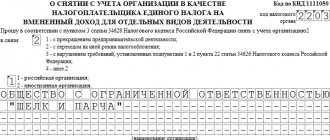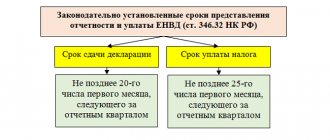Deflator coefficient for UTII
Every year until 2020, the coefficients increased, as can be seen from the values in the table for the last few years.
| Year | K1 coefficient value |
| 2010 | 1, 295 |
| 2011 | 1,372 |
| 2012 | 1,4942 |
| 2013 | 1, 569 |
| 2014 | 1,672 |
| 2015 and 2016 | 1,798 |
The decision on the size of the coefficient is made by federal authorities, and the data must be officially published before November 20.
In 2020, it was decided to increase K1 to 2.083 - by Order of the Ministry of Economic Development of Russia dated October 20, 2015 No. 772. But after discussions, changes were made to the Order by Order of the Ministry of Economic Development of Russia dated November 18, 2015 No. 854, and as a result, the deflator coefficient for 2020 for UTII remained at the 2020 level, equal to 1.798. This is the only tax deflator coefficient that did not increase in 2020.
It's about the same story since 2020. At first the coefficient was planned to be increased; for now it remains at the same level - 1.798.
Criticism of innovation
Needless to say, this decision of the Ministry of Economic Development has already been severely criticized by representatives of public organizations and human rights activists.
For example, according to the general director of the accounting department M. Korkin, the increase in the K1 UTII coefficient in 2020 will exceed the projected increase in inflation in 2020. He believes that this may cause many entrepreneurs to cease operations or go into the shadows.
SKB “Kontur” expert P. Orlovsky recalled that rising prices for goods are not always followed by an increase in the income of entrepreneurs. After all, buyers often simply start buying less, trying to save money. As a result, sales volumes decrease and profits decrease. In these conditions, he advises entrepreneurs to optimize taxation. Perhaps, in these circumstances, other taxation systems should be explored. For example, in some conditions the simplified tax system for individual entrepreneurs may be more convenient and profitable.
In turn, Boris Titov, Commissioner for the Protection of the Rights of Entrepreneurs, said that this could lead to Russia simply being left without small businesses. He noted that it is still difficult to predict what percentage of entrepreneurs will decide to give up doing business. At the same time, Titov recalled that small businesses are already in difficult conditions due to a sharp decline in demand in the domestic market. The Business Ombudsman recalled that the Russian President in his message stated the need for a moratorium on increasing taxes for business. Titov O.
November 5, 2015
Using the deflator coefficient
As stated, the deflator coefficient is necessary to calculate the tax, and is calculated using the formula:
DB * FP * K1 * K2 * CH
Where:
- BD – basic profitability, which is determined for each type of activity and is specified in clause 3 of Article 346.29 of the Tax Code of the Russian Federation
- FP – the number of physical indicators that characterize the type of activity and are contained in clause 3 of Article 346.29 of the Tax Code of the Russian Federation. Indicated for each month, and in case of changes it is necessary to specify in the month of changes (clause 9 of Article 346.29 of the Tax Code of the Russian Federation);
- K1 – deflator coefficient, equal to 1.798 in 2016-2017
- K2 – correction factor, which is determined by local authorities
- CH – tax rate. The rate is 15%, but local authorities can reduce the rate to 7.5% (Article 346.31 of the Tax Code of the Russian Federation).
The use of a deflator coefficient in the tax calculation formula changes the tax amount annually, even while maintaining other indicators. And before the decision was made that the deflator coefficient for 2016-2017 for UTII will remain at the level of the previous year, the tax was increased annually only at the expense of K1, adjusting the amount depending on the price level.
What is the essence of the UTII regime
Currently, according to paragraph 2 of Art. 18 of the Tax Code of the Russian Federation, 5 special tax regimes are applied on the territory of the Russian Federation, including UTII. At the same time, paragraph 2 of Art. 18 of the current law dated June 29, 2012 No. 97-FZ, it is determined that UTII will be in force until January 1, 2020. However, the law of 06/02/2016 No. 178-FZ (Article 2), which comes into force on 01/01/2017, pushes this date back to 01/01/2021.
The essence of UTII is that the amount of tax does not depend on the amount of income received, and the calculation is based on imputed income, the rules for determining which are contained in paragraph. 2 tbsp. 346.27 and art. 346.29 Tax Code of the Russian Federation. It is this imputed income that is the tax base for calculating UTII.
You can learn about the positive and negative qualities of UTII from the article “UTI Taxation System: Pros and Cons of Imputation”
Correction coefficient K2
The second component that significantly affects the amount of tax is the adjustment factor K2.
Unlike K1, this coefficient is set by local authorities, depending on the characteristics of the activity, it is established by the decision of local authorities in a particular municipality. The procedure for changing is not regulated, it can change every year, or it can remain unchanged for 10 years. And the value of the coefficient is also set at the discretion of local authorities - it can be in the form of a fixed value, or it can be a complex formula with a dozen indicators.
For example, in Zheleznogorsk ZATO, Krasnoyarsk Territory, there is a decision dated November 17, 2005 No. 3-11R, which is being amended. K2 is set for each type of activity, in a fixed amount from 0.01 to 0.4, different coefficients are established for the city of Zheleznogorsk and villages. At the same time, K2 has never changed for a number of services - for example, all types of household services, transport services for the transportation of passengers and goods, veterinary services and a number of others.
In the same region, in the Kozulsky district of the Krasnoyarsk Territory, the adjustment coefficient is the product of more than a dozen adjustment factors that evaluate budget financing, the location of the facility, and nuances depending on the type of activity, for example, the type of retail space or the type of parking lot. In this case, for example, the value of the correction factor that determines the type of parking varies from 0.008 to 1.
In another region, in the Aleksinsky district of the Tula region, the adjustment coefficient K2 for each type of activity is either determined by a fixed value or calculated using different formulas. For example, for household services it is determined taking into account the number of employees engaged in providing the service; for trade, it is determined by the location of the trade facility and the type of product.
Conclusion
When calculating the tax amount, it is important to take into account not only the basic profitability and physical indicators, but also the UTII coefficients for 2016-2017, which can significantly reduce the tax amount.
Moreover, if the deflator coefficient for UTII does not depend on the type of activity and other factors, but changes every year, then the adjustment coefficient may not change for years, but have different values in different municipalities, which is especially important to consider if tax registration and payment is carried out at the place of business.
Therefore, it is necessary to annually check the value of the deflator coefficient K1 and calculate in advance the value of the correction coefficient K2 when conducting activities in different cities, even in the same region.
Similar articles
- Basic yield
- Sample of filling out UTII-2 for individual entrepreneurs 2018
- Latest changes in the Tax Code of the Russian Federation on UTII
- Deflator coefficient for 2020 for UTII
- Coefficients K1 and K2 for UTII for 2020
About deflator coefficients for taxes for 2020
It goes without saying that taxes will not decrease in 2020, but will increase thanks to deflator coefficients.
Loft Art Couture - organization of space for events in Moscow. This is not only a room for rent, but also a whole range of additional services. Details on the website art-couture-loft.ru
And this growth will be greater, since in comparison with the difference in changes in the values of deflator coefficients between 2020 and 2019, the difference between 2020 and 2020 is greater. Judge for yourself:
| Tax regime | 2018 | 2019 | 2020 | Difference between 2020 and 2020 | Difference between 2020 and 2020 |
| UTII | 1,868 | 1,915 | 2,009 | +0.047 | +0.094 |
| Patent (PSN) | 1,481 | 1,518 | 1,592 | +0.037 | +0.074 |
| Personal income tax | 1,686 | 1,729 | 1,813 | +0.043 | +0.084 |
| Trade fee | 1,285 | 1,317 | 1,382 | +0.032 | +0.065 |
It turns out that such a “heavy” increase in the tax burden compared to the previous difference is almost 2 times.
Deflator coefficient for UTII
Those who pay UTII need the deflator coefficient or K1 coefficient to calculate the tax. Using this coefficient, the values of the basic profitability established in the Tax Code of the Russian Federation are adjusted (the basic profitability is multiplied by the K1 coefficient and the K2 coefficient - the latter is established by local municipal authorities).
Let us remind you that 2020 is the last year of the possibility of using UTII in an already truncated form (the use of UTII in the retail trade of labeled goods is not allowed).
In order to quickly abandon UTII in favor of other taxation systems, taxation for which depends on real rather than imputed income, the deflator coefficient for UTII for 2020 is clearly overestimated.
In this regard, it is recommended to compare the actual revenue for the quarters of the outgoing year with the value of the imputed income and estimate your real income in the next quarters of the next year, comparing with the imputed income taking into account the increased coefficient - it may well happen that the actual expected income may be less than the imputed one and then the transition to a simplified system with the object of taxation “6% income” will be more economically profitable, especially taking into account the fact that the tax in this case, as well as with UTII, is further reduced by mandatory insurance contributions by at least 50%.
But we have very little time left for this, because we will be able to abandon UTII early after the New Year celebrations, but we can switch to simplified taxation only at the end of the current year, no later than December 31st.
If we do not switch to a simplified system now, and next year, without waiting for the end of the year, we abandon UTII, then by default we will be considered to have the basic taxation system in place, according to which we need to pay personal income tax (for individual entrepreneurs - 13%) or income tax (for organizations - 20%) and charge customers VAT (20%).
Deflator coefficient for a patent
Under the patent taxation system, as well as under UTII, the deflator coefficient adjusts (increases) the maximum amount of potential annual income by type of business activity.
The basic value of the maximum possible annual income of an individual entrepreneur is 1 million rubles
Deflator coefficient for a patent
Trade fee payers use a deflator coefficient to adjust the fee rate determined for the activities of organizing retail markets.
The basic value of this rate is 550 rubles per 1 sq. m. meter of retail market area.
Deflator coefficient for personal income tax
For the purpose of calculating personal income tax, the deflator coefficient is used only to adjust payments of foreign citizens working on the basis of a patent for hire from individuals (for personal, household and other similar needs not related to business activities).
Such employees are required to make monthly fixed advance tax payments for the period of validity of the patent in the amount of 1,200 rubles.
Deflator coefficient for simplified tax system
In order to apply a simplified taxation system, the deflator coefficient is used to adjust not the tax, but the limits:
- the limit, subject to which a transition to the simplified tax system is possible;
- income limit, if exceeded, the taxpayer under the simplified tax system loses the right to apply this tax regime.
For 2020, the deflator coefficient for the simplified tax system is set as one (1.0), that is, the limits established by the Tax Code of the Russian Federation do not change and will be accordingly:
- for the transition to the simplified tax system based on the results of 9 months of 2020 - no more than 112.5 million rubles
- for a forced transition from the simplified tax system to the basic taxation system - if the income exceeds 150 million rubles.
Deflator coefficient for calculating property tax for individuals
Until 2020 inclusive, the value of the deflator coefficient for calculating property tax for individuals was established.
This coefficient adjusted the inventory value, on the basis of which the tax was calculated for some objects.
However, from January 1, 2020, the tax base for personal property tax will be calculated throughout the Russian Federation only on the basis of the cadastral value of objects. In this regard, the need for this deflator coefficient has disappeared and since 2020 it has not been assigned.
✦ Order of the Ministry of Economic Development of the Russian Federation No. 684 dated October 21, 2019






